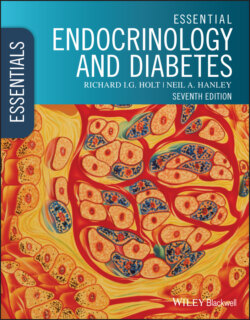Читать книгу Essential Endocrinology and Diabetes - Richard I. G. Holt - Страница 74
Nuclear receptors
ОглавлениеNuclear receptors are the second superfamily of hormone receptor. They are classified by their ligands, small lipophilic molecules that diffuse across the plasma membrane of target cells. Once ligand‐bound, the receptors typically function as transcription factors bound to DNA to regulate gene expression (Figure 3.18). This need for transcription and translation to elicit an effect means that biological responses of nuclear receptors are relatively slow compared to cell‐surface receptor signalling.
Figure 3.13 Familial male precocious puberty (‘testotoxicosis’). This 2‐year‐old presented with signs of precocious puberty. Note the musculature, pubic hair and inappropriately large size of the testes and penis. He was the height of a 4‐year‐old. His overnight gonadotrophins [luteinizing hormone (LH) and follicle‐stimulating hormone] were undetectable as testosterone was arising autonomously from Leydig cells due to a gain‐of‐function mutation in the gene encoding the LH receptor (Box 3.8).
Distinct regions of nuclear receptors can be identified, for which evolutionary conservation can be as high as 90%, i.e. the receptors are structurally related (Figure 3.19). For one sub‐group of the superfamily, no clear‐cut endogenous ligands have been identified and they are termed ‘orphan’ nuclear receptors. In addition, some variant receptors have atypical DNA‐binding domains and potentially function via indirect interaction with the genome. All the different types of nuclear receptor are associated with endocrinopathies, usually due to loss of function.
The receptors predominantly function in the nucleus. Nuclear import and export is a common and important regulatory mechanism by controlling access to target DNA binding sites in promoters and enhancers (Chapter 2). This shuttling is exemplified well by the glucocorticoid receptor (Figure 3.18).
